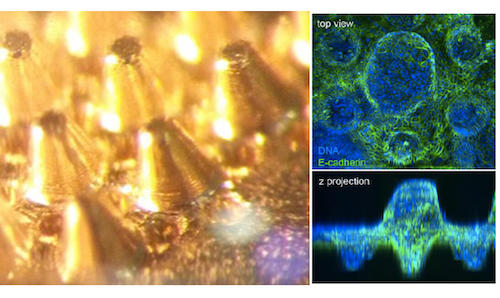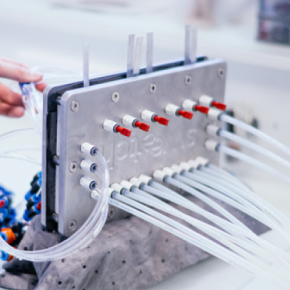What is Microfluidics ?
Microfluidics is an interdisciplinary field at the crossroads of physics, chemistry, biology, and engineering.
It explores how fluids behave, mix, and react in miniaturized systems — from droplets a few micrometers wide to complex organ-on-chip models.
Beyond its fundamental aspects, microfluidics has become a powerful enabling technology for applications as diverse as drug discovery, diagnostics, environmental monitoring, soft-matter engineering, materials synthesis, and sustainable energy.
By combining precise flow control, advanced microfabrication, and interfacial science, microfluidics offers a unique platform to mimic biological processes, accelerate chemical reactions, and design new materials at the mesoscale.
Some examples
🌈 High-throughput droplet sorting by fluorescence:
A microfluidic device routes droplets based on their fluorescence signal, reflecting the progress of an encapsulated biochemical reaction.

Source: LBC, ESPCI
🫀 Organ-on-a-Chip
Microfluidic devices that reproduce the structure and function of living tissues.
Examples
- Gut-on-a-chip: models microbiota interactions, nutrient absorption, and inflammation.
Goal: replace or complement animal testing and provide personalized medicine tools.

Source: Le Journal du CNRS
🌊 Blue Energy
Harvesting renewable energy from salinity gradients using micro- and nano-fluidic channels.
Examples
- Nanoporous membranes: control ion transport for optimized energy conversion.
Goal: design sustainable and carbon-free energy sources from natural concentration gradients.

Source: Le Journal du CNRS
⚗️ Flow Chemistry
Performing chemical reactions in continuously flowing microreactors instead of batch flasks.
Examples
- Continuous synthesis of pharmaceuticals with high precision and safety.
- Photochemical and electrochemical processes enhanced by efficient light or current delivery.
Goal: make chemistry safer, faster, and more sustainable.

Source: Le Journal du CNRS - See video
🧫 Organoids & Microfluidics
3D mini-tissues derived from stem cells, cultured and perfused within microfluidic environments.
Examples
- Brain organoids on chip: to study neurodevelopment and disease.
- Tumor spheroids: for testing anticancer drugs in realistic conditions.
Goal: bridge the gap between cell culture and real organs by recreating physiological microenvironments.
Microfluidics is thus not only a scientific discipline, but also a versatile platform enabling innovation across life sciences, materials, and energy.
Videos
Below are three introductory videos :